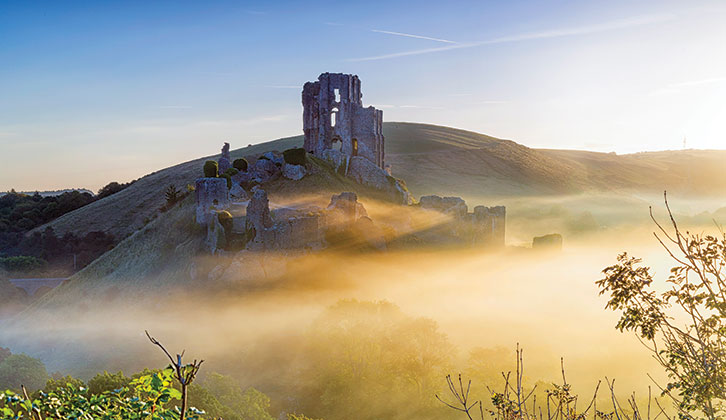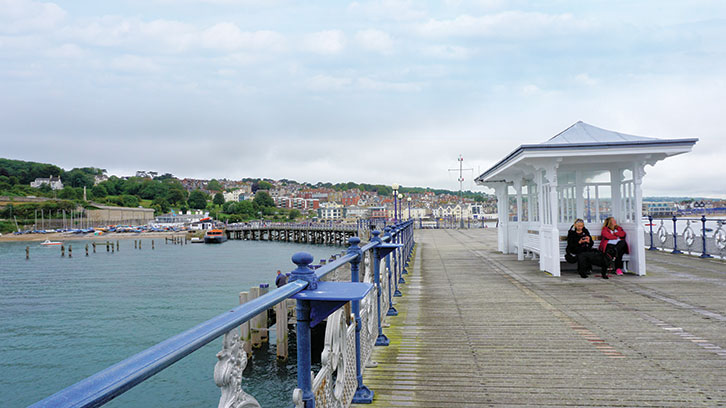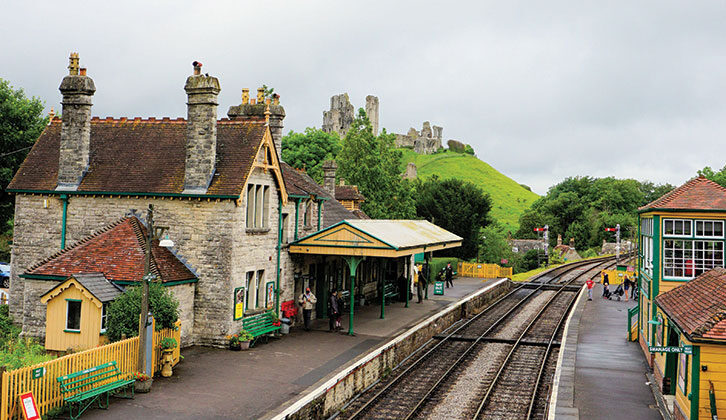As the dramatic ruined tower of Corfe Castle came into view, perched on the hilltop above the footpath that husband Ro and I were following, my thoughts turned to one of my favourite childhood books.
Enid Blyton’s Five on a Treasure Island, the first in the delightful Famous Five series, describes a ruined castle of white stone with “broken archways, tumbledown towers, ruined walls”, in which jackdaws made nests. I could easily imagine Julian, Dick, Anne, George and Timmy the dog running around the hilltop preparing for adventures – and picnics.
Enid Blyton holidayed in Dorset several times a year for much of her life, and based George’s family home at Kirrin Island on the ruined structure of Corfe Castle.
Something that a good motorhome site will always offer is a great position for exploring the surrounding area, and that’s the case with Corse Castle campsite, which was our base for the weekend. From there, the castle is a pleasant stroll of about a mile – with scenic views of the Purbeck Hills.
Ro had rolled his eyes at my re-enactment of adventuring children, but then simply couldn’t resist becoming a Norman soldier, brandishing his dried-stick-cum-sword as he defended the castle from all comers, just as William the Conqueror’s men would have done back in its heyday.
Treachery and intrigue
In fact, Corfe Castle is much older than the Norman structure remaining today, and had seen more than its fair share of treachery and intrigue long before the Famous Five were let loose there.
In AD 978, 16-year-old Edward the Martyr was murdered here by his stepmother Elfrida, who wanted her son Aethelred to be king.

William the Conqueror later fortified the castle after beating Harold at the Battle of Hastings, while early in his reign, King John imprisoned his niece, Eleanor, here – she was well treated, but 22 of her French knights were starved to death in its dungeon.
Corfe was twice besieged during the Civil War and finally fell to the Parliamentarians. The troops all but destroyed the outer walls, leaving the ruin that we see today. These days, it is a Scheduled Ancient Monument in the care of the National Trust. Much of the castle’s original stone is now to be found in the village below, where it was used to repair many of the homes that had also been damaged in the fighting.
Time for a pub lunch
Amateur re-enactments completed and a scenic stroll thoroughly enjoyed, we found ourselves in the village, also known as Corfe Castle, as the sun finally won its own battle against the cloudy skies of the early morning – the perfect time to stop and enjoy a spot of lunch.
Although there were still quite a few visitors around this late in the season, we didn’t have too much trouble finding a table at The Greyhound Inn, which has fabulous views of the castle from its delightful beer garden.
The pub sits on The Square, at the top of West Street – originally known as Duck Street, for the many animals driven along it to market and the mess they left behind.
After an excellent ploughman’s and a pint of ale from the Dorset Brewing Company, we ambled around the village, coming across what is reputed to be the smallest town hall in the whole of England, originally built using castle stone.
The current building dates back to the 18th century, and houses an equally small, but very interesting, local museum.
We also couldn’t resist indulging a few more childhood memories, with a quarter of sherbert lemons and bonbons from the traditional sweet shop – naughty but nice!
That evening, we made up for those treats with a tasty and healthy home-cooked beef casserole enjoyed in the comfort of our ’van. However, it was washed down not with lashings of ginger beer, à la Famous Five, but with a pleasant glass or two of a very grown-up red wine before our peaceful night’s sleep.
The campsite is in a great location, not only for the village and the castle, but also for enjoying several walks right from its doorstep. It is equally handy for public transport and next day, under grey skies, we took ourselves off to Swanage on the steam railway.
As we puffed our way through the Purbeck Hills, I imagined the Famous Five taking the same train after a term at boarding school, looking forward to all of the fun to be had on a summer of adventure. The leisurely six-mile journey from Corfe to Swanage, in the heart of the Dorset Area of Outstanding Natural Beauty, takes a very scenic 20 minutes.

We enjoyed a great day exploring the town, with its fabulous Blue Flag beach and splendid Victorian pier. This is also a popular spot for scuba diving, crabbing and boat trips.
Looking for lunch, we opted for fish and chips at The Ship Inn, fittingly another favourite of Enid Blyton’s. Later, we still had plenty of time to walk along the promenade and browse the gift shops and galleries before catching the heritage train back to Corfe Castle.

The last full day of our short trip to Dorset dawned bright and sunny, so it was time to go on a little adventure of our own. One reason for visiting this area was to see an iconic part of the English coastline – the famous stone sea arch at Durdle Door. This ancient structure, some 140 million years in the making and around 200ft tall at its highest point, is part of a Marine Protected Area and for us, a pleasant 30-minute drive from the Corfe Castle campsite.
Step down to Durdle Door
Parking is really easy in the Lulworth Estate pay & display car park, although the same cannot be said of the walk down the steep steps to reach the shingle beach – sturdy shoes are a must. If you don’t fancy the walk, however, the arch looks equally spectacular from the clifftop.
We had almost visited this beach many times in the past, but always put it off, with thoughts such as, “school holiday season, far too busy” or “middle of winter, far too wet”. A weekend in October, though, was judged the perfect time for that long-awaited visit. And we weren’t disappointed.
Not only the arch itself, but the splendid beaches and cliffs are worth the journey and we were both glad that we finally made the trip. As we stood on the shingle, taking in the gorgeous scenery and watching the waves around the arch, I spotted
a small dark shape bobbing about in the sea.
It was moving towards a lone swimmer, clad in a wetsuit and heading for the arch.

We were surprised to see somebody swimming here – it’s not advised by the RNLI – but imagine his surprise when this dark shape popped up!
It turned out to be a seal looking for somebody to play with – and play they did. It was fun for us to see, and must have been great for the swimmer.
Having ticked off that bucket-list view, we decided to walk a short stretch of the beautiful South West Coast Path and escape our fellow visitors for an hour or two.
Although it was undoubtedly quieter on that fine autumn day than it would be at the height of summer, I imagine there is never a moment of daylight when Durdle Door is left entirely to itself. We did manage to find some solitude along the cliffs – just us, the wildflowers, grasses and thistles, with chiffchaffs, terns and egrets above.
The views from the clifftops to nearby Man O’War Beach and further afield to Lulworth Cove are quite simply stunning. Admiring the scene, it is easy to understand the popularity of this stretch of coast: English scenery at its finest.

We decided to walk in the opposite direction, though, towards the clifftops at Bat’s Head. There are plenty of footpaths here, some climbing to Swyre Head, the highest point of the Isle of Purbeck, or descending to the valley of Scratchy Bottom (which once made it onto a list of the rudest place names in the UK!).
A set of wooden steps leads down to the beach if you want to see the smaller sea arch at Bat’s Head at closer quarters. We chose to stay on the clifftops and admire the views from there, especially as the tide was rapidly rising and the afternoon was wearing on.
Watching the sunset
It was approaching time to leave, and we took the less energetic option of returning via the cliff path. Meanwhile, back at Durdle Door, a row of people had begun to line up along the beach. What now, we thought, more seals, perhaps? But no, they were simply waiting patiently for the sun to go down.
We joined them to enjoy the spectacle. We had initially planned to visit Lulworth Castle, but we had lingered for far longer than we thought we would, strolling along the cliffs and the beach. Not to worry, though, there’s always next time.
And besides, there is something special about watching the sun slowly sinking into the sea. It really did make the perfect ending to our Dorset adventure.
But as Julian so rightly says in Five Go Off in a Caravan, “I do love the beginning of the summer hols. They always seem to stretch out ahead for ages and ages.”
“They go so nice and slowly at first,” replies his sister Anne. “Then they start to gallop.”
How very true – our trip to this lovely part of the world was over far too soon and as we headed for home the following day, we were already planning our next adventure to castles, islands and moors, in our own home on wheels.
If you’re thinking of heading to this region and are looking for a site to stay at, be sure to take a look at our best motorhome site in Dorset guide.
Touring essentials
Where we stayed
Bucknowle, Wareham BH20 5PQ
When to go to Corfe Castle
We chose to avoid the main summer season and to visit during October, towards the end of the season, but before the winter weather set in.
Way to go
From Buckinghamshire to the Purbeck Hills and the Dorset coastline around Corfe Castle, we took the M3 and M27 before following the A31 through the New Forest and finally taking the A351 to Corfe Castle.
Find out more
Head to our Best of British: Touring Adventures category to find more great travel ideas and inspiration.
Lead image: Getty Images
If you’ve enjoyed reading this article, why not get the latest news, reviews and features delivered direct to your door or inbox every month. Take advantage of our brilliant Practical Motorhome magazine SUBSCRIBERS’ OFFER and SIGN UP TO OUR NEWSLETTER for regular weekly updates on all things motorhome related.






















